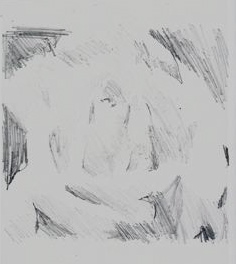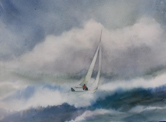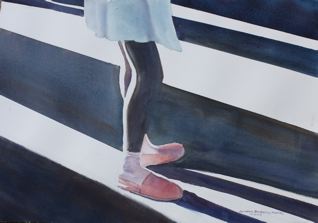![photo[7]](/wp-content/uploads/2016/04/photo7.jpg)
A student recently sent me a photo of a rose in her garden. I replied, “What a wonderful subject, so full of lost and found edges!
She wrote back that she didn’t see any, “It is not very evident which edges to soften as they seem all distinct (maybe some more distinct than others?). Does this sound familiar? Here is the rose. Do you see the lost and found edges?

Here is a black and white of the rose. Does taking away the color make it easier to see potential lost and found edges? You might print this and mark the edges that you would choose to disolve into a neighboring shape.
 I find it easier to start drawing, not contours but shapes of values. On the left is a drawing I did of areas where I would paint. Do you see shapes flowing into shapes?
I find it easier to start drawing, not contours but shapes of values. On the left is a drawing I did of areas where I would paint. Do you see shapes flowing into shapes?
My suggestions to you would be:
- Whatever the subject, start drawing (on sketch paper) without edges or contours. Look for places where one value can be the same as in the neighboring shape and link these.
- When you draw (contours) your subject up on your watercolor paper, using your shaded drawing,ERASE the part of the line where one value is flowing into the next.
- When you are painting be sure your paint flows through that passage at the value you have indicated.
How do you know WHERE you can let a shape flow into another when you can only see distinct edges.
Easy…If you indicate where a line (edge) starts and where it encounters another shape, you can usually let it disappear along the way.
 On the left is a painting I made up of a boat sailing in heavy weather – after I was down on our dock on a winter’s day. Clouds are merging with the water. Trace along the clouds where they are separated from the sky and then see how the edges dissolve into the water. Much of the sails are lighter than the clouds but there is a section of each where is the same value as the water. I could have had more the same value as the clouds aslong as I was clear about where the edge started and stopped.
On the left is a painting I made up of a boat sailing in heavy weather – after I was down on our dock on a winter’s day. Clouds are merging with the water. Trace along the clouds where they are separated from the sky and then see how the edges dissolve into the water. Much of the sails are lighter than the clouds but there is a section of each where is the same value as the water. I could have had more the same value as the clouds aslong as I was clear about where the edge started and stopped.
Again, with the hull of the boat, part of the edge dissolves into the water. This lost and found helps to convey the sailboat at one with the elements.
 The painting on the left moves from focused tulips to less and less defined shapes implying tulips.
The painting on the left moves from focused tulips to less and less defined shapes implying tulips.
You can help direct the focus in the painting by moving from in-focus shapes to less and less defined. Study which edges are fully described, in contrast to their neighboring shape, and which are lost and found (partially described) and which are blobs of paint we accept as tulips because of this graduated change of focus. Do you find it more pleasing that if each tulip had been painted as clearly as the central few?
I believe the reason we find this more pleasing is that this is how we are truly seeing. If we were looking at the central tulips and the cabin beyong them, the landscape to the right and left of our focus would be out-of-focus color blobs. Try it by becoming aware of what is beyond your computer screen while you continue to look at the words here. You see out-of-focus shapes of lights and darks and various colors. … Not much beyond the the screen is in focus. How do we paint these merges?
In Shadows at the Exhibition, I was interested in losing and finding the edges of this little girl’s legs against the strong pattern of sunlight and cast shadows on the floor.
 The front of her right leg is in contrast to the sunlit floor, past her knee so the bend in her leg is explained before it disappears (is lost) into the cast shadow on the floor, only to be caught and described again by the white sock on her left foot.
The front of her right leg is in contrast to the sunlit floor, past her knee so the bend in her leg is explained before it disappears (is lost) into the cast shadow on the floor, only to be caught and described again by the white sock on her left foot.- The sunlight on the back of that leg is described until it reaches her sock. There it merges with the light floor. We accept that some of the white is sock and the back of her shoe because of small shadow shapes in the wrinkles that tell us of the width of her ankle and foot.
- In the same way see if you accept that the thigh of her left leg is “readable” against the white floor even though nothing is actually shown.
Lost and found is just one aspect of painting looser. SEEING the lost and found shapes comes first. Work on that for now. Next month we will take it further.
Happy painting — and LOOKING!
Caroline
©2014 Caroline Buchanan
